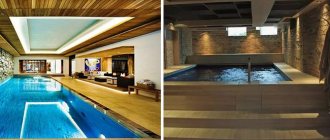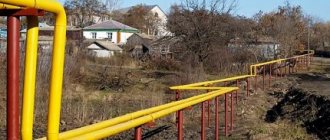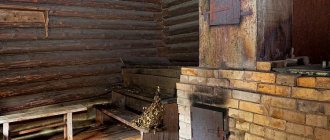At what distance from the house a bathhouse can be built is an important question on which the comfort of the inhabitants of a residential building, its aesthetic appearance and all-round safety depend. The provided standards are designed for simultaneous compliance with SNiP (building codes and regulations), SanPiN (sanitary rules and regulations), as well as fire safety requirements and rules. Compliance with the reasonable distance of buildings specified in the rules provides for equal importance of all necessary distances. It is important to maintain a distance from the sauna both to your own home and to the neighboring house where another family lives.
Bathhouse in the village
Distance of the bathhouse from the neighbors' house
If you do not take into account the requirements prescribed in SNiP, then in the event of an emergency, neighbors may demand to answer according to the law. It is important to comply with sanitary standards regulating the distance between the bathhouse and the neighbor’s house. This will eliminate the emergence of all kinds of conflicts with the owners of neighboring country houses.
The edge of the plot must be at a minimum distance from the sauna, equal to at least 1 m. The calculation of the distance of the structure from the neighbor’s house will be correct if we take into account not only the boundaries of the land plot or the distance of the structure from the fence.
It is important to take into account the location of each building relative to the future steam room, including objects on the neighboring site.
Distance from the bathhouse to the neighboring house
When calculating the distance from the bathhouse to the neighboring house, you need to take into account not only the proximity of the site boundary, but also the location of all buildings. So, the bathhouse should be located at least a meter from the edge of the site, while the distance to the neighboring house should be 8 meters or more. Structures for draining water from the bathhouse should be installed at least 1 meter from the fence, and the water should not fall into the neighboring area. If this is a trench, then it should be filled with a mixture of sand and gravel. The legislation does not divide baths by type. But if you plan to build a black bathhouse, it is recommended to increase the distance to it to 12 meters to further reduce the risk of fire.
In areas with very dense buildings, the construction of any bathhouse with a chimney is not allowed at all.
This also needs to be taken into account when designing the site and clarification of this issue in advance from the management of the dacha cooperative.
Installation of different types of baths
Before erecting a structure, it is important to determine the type of future construction. Baths can be smoky or non-smoky, therefore, according to the regulations, the requirements for the first type of structure are as follows:
- Build taking into account the wind rose, since the wind can strongly blow smoke towards neighboring houses.
- Do not build in densely populated areas.
- Maintain a distance of 12 m from the bathhouse to the residential building.
Interior
If you plan to build a bathhouse that needs to be heated, then the distance from this building to the country house should be kept at 12 m. It is better if the building is located on the side of the site where the wind blows more intensely and frequently. This will further reduce the risk of fire hazard.
Smoke-free baths, or white baths, must be installed taking into account sanitary standards:
- away from the neighbor's house;
- arrange a ventilation system;
- waterproof the steam room.
Installing a building in white will significantly provide savings on the arrangement of a water supply system and sewerage system on one site. There are no norms in the legislation that prevent the placement of sauna structures together with residential buildings. In any case, it is better to coordinate such projects with architects and design specialists.
Combination of baths and other buildings
Modern baths are often combined with a garage structure, a residential building or a summer house. The legislation does not indicate anywhere that the construction of such structures is prohibited by regulations. Sanitary standards apply only to the construction of washrooms or toilets.
Location on
The distance from the bathhouse to the house is established by SNiP, SP and SanPiN standards. All standards have been developed for free-standing structures. A steam room in the form of a Finnish sauna is an extension, the operation of which is associated with certain risks:
- fire hazard;
- ingress of wastewater into the ground;
- soil contamination.
Fire standards for the distance from the bathhouse to various buildings are similar to the sanitary standards, which are regulated by SNiP 30-02-97 as amended in 2020 and SP 53.13330.2011. Fire safety standards have not been established for grouped buildings and structures, including those located in neighboring areas.
Construction documents and recommendations
Correctly positioning buildings on a site is a complex process that requires taking into account many components.
The specifics of the construction of sanitary facilities are the subject of close consideration by supervisory organizations that strictly check compliance with the prescribed standards.
Building at the dacha
There is even a legislative decree on the types of toilets, in the absence of a central sewerage system. Its publication is due to the need to maintain epidemiological safety and prevent pollution. The minimum distance for such objects is the main requirement when constructing a septic tank, cesspool, well and well. These rules and principles are still relevant in 2020.
- The distance from the bathhouse to the neighbor’s house must be strictly observed, because such a building is both a source of wastewater pollution and a source of potential fire. Regarding the question of the need to register a bathhouse on the site, even if it does not stand on a foundation, it is still better to obtain a construction permit in advance.
- When deciding to build a bathhouse on your site, you need to take into account too many rules and regulations, in which proper distance is placed at the forefront. If the site is relatively small and there are already buildings on it, state registration will help take into account all the necessary nuances and norms. Transferring an object on a plan drawn on paper will be much less difficult if it was not possible to maintain a distance from the house and experts have indicated this, than transferring it in reality.
- Accounting for the type of building, its dimensions and materials of construction, as well as the location of other buildings on one’s own and neighbor’s property is carried out by government agencies. Making a decision on the possibility of registration according to the law, in an official manner, will make it possible to repel any boors who are dissatisfied with any circumstances.
Interesting interior of a bathhouse on the site
Instead of studying numerous SNiP, SP, Town Planning Code and SanPiN, it is easier to consult with a competent lawyer who deals with relevant issues in construction. Having placed the desired building in full compliance with all standards, including fire safety ones, obtaining permission according to the law will not be difficult at all.
Proper bath design
To ensure that the operation of the sauna does not create problems for your neighbor, it is necessary to design it taking into account sanitary standards. This will reduce the risk of damage to the property of the owner of the site and his neighbors. The surface of the outer wall of the residential building should be taken as the reference point for the distance from the bathhouse to the neighboring residential building.
Typical location
To reduce the threat to the life and health of people, all aspects must be thought out, from the type of material used in the construction of the bathhouse to the distance separating the building with the steam room from the residential building. This will allow you to avoid fines for non-standard use of the bathhouse. It can be chopped or laid out of brick, but it is very important to comply with the requirements for the placement of the structure.
Construction of baths from different materials
When determining at what distance to place a bathhouse built from a particular building material, it is important to take into account the recommendations:
- Make the entrance to the steam room on the south side, since this is a warmer area and there is less snow in winter.
- Place windows in the western or southwestern part of the building, where sunlight reaches the maximum amount.
- Ensure good visibility of the structure and its entrance from the windows of the country house.
Layout of buildings according to SNiP
You need to build a wooden bathhouse on your own site at a distance of at least 15 m from the neighboring bathhouse structures. If a brick sauna borders a wooden building, then according to the rules, it is better to reduce the distance between the wooden structure and the bathhouse to 10 m. A brick building can be located at a closer distance (about 6 m from the gas bathhouse).
Where can you build a hygienic structure?
The construction of a bathhouse is legally possible on any plot of personal property, provided that it is located in accordance with existing standards and is not used for commercial purposes. The concept of norm means the need to comply with existing rules, which stipulate at what distance objects should be placed.
Fire regulations in a small summer cottage cannot always be observed due to lack of space, as well as sanitary ones. In such cases, SNiP standards are taken into account. Since 2010, they have been considered at the level of legislative regulations.
In the village
Permission to build a bathhouse can be obtained for the following forms of land ownership:
- privately owned, with a private residential building built, regardless of its location (private sector in the city, town, district center, rural area or village);
- form of ownership - personal subsidiary plot (LPH), where not only the construction of individual housing construction is allowed, but also the construction of economic buildings, as well as agricultural activities;
- a plot consisting of SNT, where you can build residential buildings, do gardening work and keep a small number of livestock;
- dacha plots, members of a dacha consumer cooperative (DCC), if the size of the plot and the rules provided for by the charter allow.
Scheme of placement of objects on individual housing construction and SNT sites in accordance with SNiP and SanPiN
A building permit can be obtained by providing a detailed design and layout of the remaining buildings, indicating the building materials and the type of proposed hygienic facility (sauna, bathhouse, steam room). If a building shown on a detailed design requires a permit, the question of whether registration is required is clarified.
A steam room that has received the status of a permanent structure due to the specifics of the project must be registered. This will make the owner’s life much easier in the future if he has friction with neighbors, the need to sell private property or pass it on by inheritance. Insurance and donation of property will also require mandatory registration.
The list of documents is small - you only need to provide a document confirming ownership, a layout diagram showing each building (both actually existing and proposed, down to a small barn), and a general plan of the territory belonging to the owner.
Standard distances from the fence according to SNiP standards
Requirements for placing baths
The distance between the house and the bathhouse must be observed in accordance with the rules regulated by SNiP 30-02-97 as amended for 2020, as well as SP 53.13330.2011. These documents indicate all the features of the placement of buildings on the site.
Distances between them must be maintained, since proper operation of various objects is impossible without this. In accordance with the instructions and fire safety requirements, the distance between the bathhouse and various structures should be:
- from a garden house in a village - more than 3 m;
- from a utility structure – from 1 to 4 m;
- from a well, toilet or composting facility – 8 m;
- from shower or sauna – 8 m.
Rules and regulations
The construction of the drainage system should be carried out at a distance of no less than 1 m from the fence of the neighboring area, where water should not flow.
It is better to cover the drains, which are a trench, with a layer of a mixture of sand and gravel.
Fire safety
The standards of Federal Law No. 123-FZ are designed to protect the house and barn from fire in the event of a fire in neighboring buildings. The shed can be located at a distance of 6 m from the neighbors’ residential building or apartment building if it is built from fire-resistant materials:
- Brick.
- Concrete.
- Metal.
- Glass.
Wooden building
If the building does not contain animals and birds, there are no flammable or flammable objects, the distance from the border of the site can be 1 m, from the neighbor’s house and its windows - 6 meters.
The distance from the barn to the neighbor's house can be reduced by agreement with the neighbor to 4 m if the wall facing the outbuilding has no windows into the living quarters or is completely blank.
The agreement is drawn up in writing and legally certified. It is valid for an unlimited time, until it is replaced by one of its owner’s plots.
Compliance with fire regulations
An important characteristic taken into account when dividing materials for construction into classes is fire resistance. This property is important to consider when placing a sauna. The samples used for its construction can be flammable or non-flammable, for example, wooden beams or bricks. Their division into classes is as follows:
- Non-combustible including stone, concrete, brick - 1st class.
- Mixed, when wooden floors are combined with steel elements - 2nd class.
- Combustible including wood materials and their substitutes - 3rd class.
When choosing a particular material, it is important to pay attention to the division of samples within the classes listed above depending on the use of impregnation. Buildings with roofs made of non-combustible materials should be located at a distance of 6 m between them. The distance from the bathhouse to the neighboring house should be 12 m if the roofs of the buildings are made of flammable materials.
Standard distances
The distances between a brick residential building and a wooden roof and a sauna should be selected taking into account the type of flooring or roofing material of a building with a steam room:
- flammable – 10 m;
- flammable - 12 m;
- woody – 15 m.
Designing a bathhouse requires a careful approach, maintaining the distance between the stove units inside the steam room. The equipment inside the bathhouse must be installed in accordance with all rules and requirements of sanitary and fire safety.
When building a bathhouse, you should remember that the cause of a fire can be not only the contact of wood with fire. Prolonged heating of equipment to temperatures above 100 °C can cause a fire. In order to prevent a fire, it is important to observe not only the distance of the bathhouse from residential buildings and other objects on the site, but also to correctly install high-quality equipment inside the steam room.
What other standards to consider?
When placing buildings on the site, it is also necessary to take into account the norms of distances from the neighbor’s fence:
- to the toilet on the street in SNT or individual housing construction - 1 meter;
- to the greenhouse on the garden plot or in the vegetable garden - 1 meter;
- to a residential building in a cottage village or on a summer cottage - 3 meters.
Minimum distances in SNT according to SNiP
These standards are in the nature of recommendations, however, they must be followed to avoid conflicts with neighbors. Often disputes arise due to the installation of blind and too high fences. Such disagreements often lead to litigation.
Planning as the basis of construction work
The location of the bathhouse on the site is not the whim of its owner, but very often the result of a confluence of many circumstances. The areas are different. Somewhere, a dozen hectares of reserved land are attached to a palace-mansion, and somewhere, less than six acres, are huddled on slopes, inconveniences, and old, many years ago, abandoned landfills. It is clear that the neighbors and the sun-faced owner of the palace do not care about the rules for building a bathhouse on the site. On the one hand, due to the lack of laws and rules for such a figure, on the other hand, due to the absence of these same neighbors. At least those who will appeal something. Another thing is a standard piece of land for the owner of this life - the people. On less than 6 acres, to build a house, plant a garden, arrange a vegetable garden, a gazebo, and even a bathhouse, and not make enemies in the process, is akin to high art.
Finding out how much space the bathhouse takes up on the site, how many meters from the fence and other objects is a good reason to pick up a tape measure and go out into the yard.
The standards for building a bathhouse on a summer cottage are clearly stated and, if you follow them, many problems can be avoided. Let's look at the table:
| Type of development or location of the property | Distance, in mm. |
| Your dacha is located in the east, south or west, relative to your neighbors’ dacha | Not less than the distance from the lower level of the plinth to the cut of the ridge |
| From the house to the border of the roadway | Not less than 3000 |
| Garages can stand alone, be built in, or attached to other outbuildings within the site | The distance from outbuildings to the boundaries of streets and street passages is at least 5000. In relation to the garage, it is allowed to place the entrance gate on the line connecting with the street passage |
| Outbuildings may be adjacent to the garden house | From buildings to the border of the adjacent plot at least 1000 |
| From the garden house to the toilet, if one is located outside the house bathroom, and the street cellar | 12000 |
| From a permanent home built from mineral building materials to a neighboring house built from wooden elements | 8000 |
| From a permanent wooden house to a neighboring wooden house | 10000 |
| From the house to the street boundary line | 5000 |
| From a well, a water well to a latrine, a composting pit, a place for temporary storage of household waste | 8000 |
| Distance from home to bathhouse, summer shower | 8000 |
| From the bush to the border of the neighboring plot | 1000 |
| From the trunk of a medium-sized tree to the border of the neighboring plot | 2000 |
| From the trunk of a tall tree to the border of the neighboring property | 4000 |
These are general site planning rules that allow you to generally navigate the question of where to build a bathhouse on the site.










